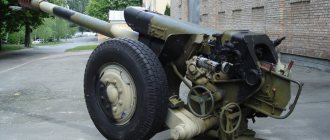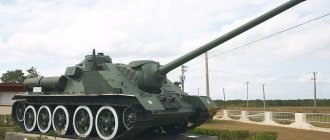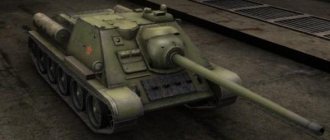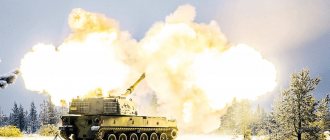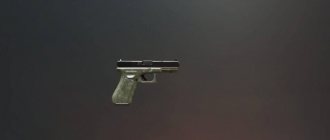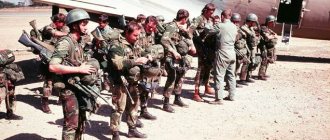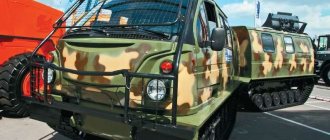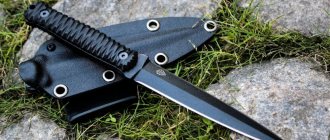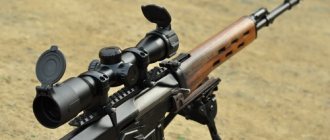105 mm German light field howitzer
105-mm German light field howitzer
mod. 1918, rate of fire 4-6 rounds per minute with an initial projectile speed at the muzzle of 470 m/s - a German artillery gun of the appropriate caliber, during the Second World War, which during the battles of this global world conflict constituted the main striking force of the field artillery of the troops and Wehrmacht This howitzer was part of the staff of the German small-caliber divisions of artillery regiments and was the main force of the German divisional artillery, as evidenced by official data, which states that for all time and in total there were 7076 of them in service with the German army, and in total, together with their modifications, there were 11,795 units were transferred to the troops.
The leFH was produced in four modifications - leFH18, (18M), (18/40) and (18/42) and each new model differed from the previous one in its greater firing range and horizontal aiming angle; the artillery part of the leFH18 was used in the assembly of the Wespe self-propelled gun. Weighing almost 2 tons, this howitzer required 3,200 man-hours to manufacture, and the total cost of the gun cost the German people 16,400 Reichsmarks.
To fire from a 105-mm leFH 18 howitzer with a crew of 6 people, six charges were used, which could be configured depending on the required firing range, and the standard b/c included
shells for various purposes
, designed to hit different types of targets and support infantry : -FH Gr 38 - a conventional HE projectile with a total weight of 14.81 kg with a charge of 1.38 kg of TNT; - Pzgr projectile - an armor-piercing projectile of the first type weighing 14.25 kg, of which trinitrotoluene was 0.65 kg. and they fired at the 5th charge, capable of accelerating the ammunition to a speed of 395 m/s, necessary to penetrate the armor of more tanks of that time at a distance of 1500 m; - Pzgr rot is a modified blunt-headed armor-piercing projectile with a ballistic tip, which contained 400 grams of explosive with a total weight of more than 15 kg. 15.71 kg, explosives - 0.4 kg. and after firing the fifth charge, the gun confidently provided armor penetration at a distance of 1500 m with an angle of impact into the armor at an angle of 60° - 49 mm; — cumulative projectile Gr 39 rot HL/A, weighed 12.3 kg and easily burned through 250 mm of armor; - the very first model of a smoke projectile, weighing 14 kg, for FH Gr Nb - which, when exploded, created a dense cloud of smoke with a diameter of 25–30 m; - second type of smoke projectile FH Gr 38 Nb - more advanced 7 kg; - Spr Gr Br - a standard incendiary projectile weighing almost 16 kg and a propaganda projectile weighing 12.9 kg. not included in the ammunition load and supplied, if necessary, to the firing position.
The history of the leFH system guns began on the first day of summer 1927, when the Reichswehr Armaments Department (Heerswaffenamt) made the historic decision to begin modernizing the battle-tested World War I standard 105 mm howitzer leFH 16. As one would expect, work on this The project was carried out by the Rheinmetall concern. From the very beginning of the work, when studying the assignment, it became clear to the designers that the matter would not end with just modernization. First of all, it was necessary to increase the firing range and significantly expand the horizontal aiming angle. The first issue was solved by lengthening the barrel to 28 calibers, accordingly modifying the recoil devices and the balancing mechanism. The second problem was also quickly solved by using a carriage of a ready-made design, based on a similar unit of a design 75-mm long-range WFK gun that had not been created at all.
By the beginning of 1930, the development of such a howitzer model was completed, and field tests began, which, like the creations themselves, were carried out in an atmosphere of absolute secrecy. For the same reason, it received the name 10.5 cm leichte Feldhaubitze 18–, which was not typical for its design, which in Russian meant 10.5 cm light field howitzer mod. 1918. Basically, this gun was abbreviated as leFH 18 and ultimately, after 5 years, it was adopted by the Wehrmacht on July 28, 1935, and serial production immediately began.
At first, the Rheinmetall-Borsig enterprise located in Düsseldorf had a monopolist in production.
Subsequently, the production of howitzer combat units was established at other weapons factories in Borsigwald, Dortmund, and later Magdeburg, and by September 1, 1939 of the war, the Wehrmacht received 4 thousand leFH 18
, and in general these enterprises could produce 115 units within a month such howitzers.
In terms of economic indicators, the leFH 18 was more successful and cheaper not only than artillery systems of larger calibers, but even anti-tank guns. The barrel of the newly assembled howitzer was six calibers longer than that of the leFH 16 and its total length was 28 calibers (2941 mm, respectively) and according to this characteristic the leFH 18 could be classified as a howitzer-gun and was a single piece with right-hand rifling, of which there were 32 pcs. The shutter is semi-automatic, wedge-type, horizontal. The barrel is rifled right-handed (32 grooves). The POU is a hydraulic recoil brake, and the knurling brake is hydropneumatic. Thanks to the increased barrel length, it was possible to seriously improve the ballistic characteristics of the gun - the initial velocity of the projectile at the muzzle, when using a full charge, was recorded at 470 m/s, which is 75 more than that of the leFH 16. At the same time, the firing range also became larger (maximum and effective) - from 9225 to 10675 m.
The beds had coulters - sliding, riveted, rectangular in profile, thanks to which it became possible to increase the horizontal aiming angle of the new weapon compared to the outdated leFH 16 by 14(!) times - from 4° to 56°. The vertical aiming angle also became larger, increasing to +42° and practically providing the maximum firing range.
All these improvements were a gift for the artillerymen, but the increased weight of the le.FH18 when towing became more than 600 kilograms and the entire gun began to weigh almost 3.5 tons and the German command requested the supply of more vehicle tractors to the troops, which were already in short supply and accordingly, the main means of moving most of these supposedly light howitzers was a team of 6 horses.
The early le.FH18 models were characterized by large wooden wheels, which were later replaced by cast wheels with lightening holes made of light aluminum alloy with a diameter of 130 cm and a width of 10 cm. The wheel travel of the howitzer had suspension mechanisms and a brake. The wheels of such howitzers were equipped with steel tires, which were sometimes covered with rubber strips. For units adapted for mechanical towing, wheels made of gummatic or sponge rubber were used. The transport speed of such a weapon could reach up to 40 km/h, and horse artillery could travel this distance all day.
From the very first battles, it became clear that the new le.FH18 howitzers were an effective offensive support and cover weapon, but the short firing range was clearly short. Due to the large safety margin, the opportunity was used to increase the initial velocity of the projectile, and therefore the firing range, through the use of an enhanced powder charge. Accordingly, it was necessary to change the POU or apply a muzzle brake. Therefore, following simple logic, in 1940 a new version of the howitzer, equipped with a two-chamber active-reactive type muzzle brake, saw the light of day. This modification had the index leFH 18M, where the letter M denoted the presence of a muzzle brake. The howitzer firing tables have also been changed.
The barrel length of the new modification leFH 18M, equipped with a muzzle brake, has now reached 3308 mm versus the original 2941 mm, which characterized the basic assembly. Accordingly, the weight of the gun also increased by 55 kilograms. Especially for the increased firing range, manufacturers developed a more powerful, number 6, high-explosive fragmentation projectile loaded with 2.1 kg of TNT - 10.5 cm FH Gr Fern, with a total weight of 14.25 kg. which had an initial velocity at the muzzle of 540 m/s, which corresponded to -12,325 meters of hitting a target from a closed firing position. Production of the leFH 18M gun version continued almost until the defeat of Germany. In total, the Germans produced 6,933 of these guns, which went to the front. The appearance of the next one, more adapted to off-road movement, was based on the experience of combat operations precisely on the Eastern Front, where, in conditions of absolute relative impassability, which was a symbol of the USSR, heavy leFH 18 howitzers got stuck in a dirty mess and lost their ability to tow, and this was not only with horse traction, but also even 5-ton half-track tractors were useless.
Therefore, in March 1942, German gunsmiths were given another technical task for the urgent design of a new, more passable carriage for this German weapon, which, above all, required time. Based on this, the Hans designers took the quick and, most importantly, the right path, mastering the barrel of the leFH 18M howitzer on the already existing carriage of the 75-mm Pak 40 anti-tank gun and quite quickly this kind of “hybrid” was adopted by the German army under a designation that combined two leFH 18/40 guns.
This combat combination had 250 kg in combat position. less mass than the leFH 18M, but at the same time, due to the low elevation angle of the anti-tank gun due to the reduced diameter of the wheels, it could not fire at maximum aiming angles. Therefore, it was necessary to additionally use new wheels of larger diameter. The muzzle brake was also modernized, which could not withstand the firing of new, more powerful armor-piercing 10.5 cm Sprgr 42 TS sabot shells and no longer provided the necessary inhibition of barrel rollback, and the start of mass production of leFH 18/40 was delayed until March 1943. By July, 418 were delivered new howitzer guns, and by the spring of 1945 the troops received 10,245 leFH 18/40 (in 1944 alone, 7,807 of these guns were produced and this fact greatly upset the Soviet command and the allies, who bombed the three main factories producing leFH 18M
- located "Schichau" in Elbing, "Krupp" in Markstadt and "Menck und Hambrock" in Hamburg.
But the howitzer quickly became outdated and the newly created model of the gun for the German army, known as leFH 18/42, differed from earlier models with a new muzzle brake and a barrel extended to 3255 mm, which slightly affected the firing range, which was only 12,700 m. Not much, no more than 60° - the horizontal aiming angle has increased and for this reason the armament department of the ground forces rejected this product, motivating its decision by the lack of improvement in fire capabilities compared to the previous leFH 18M and its heavy weight.
The prototype of the Rheinmetall group of enterprises turned out to be the most successful. The gun, with a more simplified name leFH 42, fired at a distance of up to 13,000 m, providing a horizontal firing angle of 70° with a mass of the entire structure in the firing position of 1,630 kg. Even in this successful case, the German Armament Department did not allow serial production and the development of the Skoda continued, which carried new solutions and ideas, among which were the Vespe self-propelled 105-mm howitzers and which were not implemented in practice and in fact the leFH 18 and its modifications were destined to remain the main unit of field artillery of the troops and the Wehrmacht until the complete completion of WWII in Europe.
By the end of the war, despite huge losses, especially on the eastern front, the number of 105 mm howitzers continued to remain very large. For example, on May 1, 1944, the Wehrmacht had 7996 howitzers, and on December 1 - 7372 (however, in both cases, not only towed guns were taken into account, but also self-propelled 105-mm Vespe howitzers).
But this field howitzer in all its modifications leFH 18, leFH 18M and leFH 18/40
until the mid-60s, they were in service in the Warsaw Pact countries, and with all its greatness, the artillery units of Hungary until the end of its existence used horse traction to move the artillery system.
See also[edit]
- List of US Army weapons by supply catalog designation (SNL C-21)
- List of US Army weapons by supply catalog designation No. Group "R" Material (Projectile (Projectile) No. Separate charge in case) Ammunition for 105 mm M2, M2A1 and M4 howitzers (AIC R1Q or R1U)
- The L118 Light Gun is a lightweight 105mm howitzer designed in the 1970s.
- LG1 - modern lightweight 105 mm howitzer
- G7 - modern 105 mm howitzer
- The M56 105mm is similar to the M101 produced in the former Yugoslavia and still in production in Serbia, including the new and old variant and only the old Bosnia variant
Self-propelled guns[edit]
Vietnamese self-propelled gun M101.
- Medium Tank M4A4E1 - M2A1 in T70 mount. [11] : 568
- Medium Tank M4 (105), M4A3 (105) - M4 in M52 mount. [11] : 568
- Medium/Heavy Tank M45 - M4 in M71 mount. [14] : 233
- Experimental installation on a Holt tractor - M1920. [15] : 317
- Experimental chassis designed by J. Walter Christie - M1920. [15] : 317
- 105 mm Howitzer Motor Carriage T9 (based on the Cletrac MG-2 tractor). [15] : 329
- Motor Carriage T19 105mm howitzer (based on the M3 half-track) - M2A1. [16] : 236
- 105mm howitzer with carriage motor T32/M7 - M2A1. [11] : 568
- Motor Carriage T76/M37 105mm howitzer (Light Tank M24 chassis) - M4 in M5 mount. [15] : 329
- Motor Carriage T88 105mm howitzer (76mm GMC M18 chassis) - M4 in M20 mount. [15] : 334
- 105 mm K105HT howitzer mounted on a 5-ton armored truck built by Samsung Techwin for the Republic of Korea Army.
- Vietnamese M101 howitzer on a Ural-375 D 6x6 truck. [17]
Use in Germany and Finland.
The guns captured by the Germans were designated 10.5 cm K 13 (r) and K 29 (r), respectively, and were in service with coastal defense units. For example, in May 1941 there were 11 four-gun batteries armed with Polish guns stationed in Norway.
In October 1940, the Germans sold 54 wz.1929 guns to Finland, where they received the index 105 K / 29. They were used against the Soviet Union throughout 1941-44, as part of five heavy artillery battalions and were used mainly for counter-battery warfare .
In 1944, eight guns were lost. The rest, being equipped with pneumatic tires, were stored in warehouses for a long time after the Second World War. It should be noted that Finland also used 12 105 mm Mle 1913 guns purchased in France (105 K / 13).
Operators[edit]
The Royal Thai Army fires extended range ammunition from the M101 modified with an LG1 L/33 cal barrel.
- Argentina [22]
- Australia
- Austria: Haubitze M1A2
[
citation needed
] - Bahrain
- Bangladeshi variant of M101A1
. 50 delivered in 1982. Status unknown. [23] - Belgium [24]
- Benin [25]
- Bolivia [26]
- Bosnia and Herzegovina
- Brazil [27]
- Burkina Faso [28]
- Cameroon [29]
- Canada Designated C3 [30] - Canadian C1 [24] (M2A1) with a 33 caliber long barrel.
- Chad [31]
- Chile [32]
- Republic of China [33]
- Colombia [34]
- Croatia
- Denmark [24]
- Dominican Republic [35]
- Ecuador [36]
- Ethiopia
- El Salvador
- France [24]
- Gabon [37]
- Germany (only as a salute gun)
- Greece [24] [38]
- Guatemala [39]
- Honduras
- Indonesia
- Iran [40] [41]
- Iraq [40]
- Japan
- South Korea [42]
- Khmer Republic
- Laos [43] [44]
- Lebanon [45]
- Liberia [46]
- Lithuania [47]
- North Macedonia [48]
- Malaysia
- Mauritania [49]
- Madagascar [50]
- Mexico [51]
- Morocco [52]
- Mozambique [53]
- Myanmar - 242 in service [54]
- Netherlands [24]
- New Zealand
- Nicaragua
- Norway [24]
- Pakistan [55]
- Paraguay [56]
- Peru [57]
- Philippines [58]
- Portugal [24] [59]
- Rhodesia [60]
- Rwanda [6]
- Saudi Arabia [61]
- Senegal [62]
- South Africa [63]
- Spain [24]
- Sudan [64]
- Thailand [65]
- Go
- Tunisia [66]
- Türkiye [24] [67]
- USA [68]
- Uruguay [69]
- Venezuela [70]
- Vietnam [3]
- South Vietnam
Links[edit]
- Hogg, Ian W. (1998). Allied artillery of World War II
. Crowwood Press, Ramsbury. ISBN 1-86126-165-9. - Hunnicutt, R.P. (1971). Pershing: The History of the T20 Series Medium Tank
. Feist Publications. - Hunnicutt, R.P. (1992). Stewart: The Story of the American Light Tank
. Presidio Press. ISBN 0-89141-462-2. - Hunnicutt, R.P. (1994). Sherman: The Story of the American Medium Tank
. Presidio Press. ISBN 0-89141-080-5. - Hunnicutt, R.P. (2001). Half-Track: The History of American Half-Tracks
. Presidio Press. ISBN 0-89141-742-7. - Technical Manual TM 9-1325, M2 and M2A1 105mm Howitzers;
Strollers M2A1 and M2A2; and installations for M3 and M4 combat vehicles . War Department, 1944. - Technical Manual TM 9-1901, Artillery Ammunition
. War Department, 1944. - Technical Manual TM 9-1904, Ammunition Inspection Manual
. War Department, 1944. - Technical Manual TM 9-2005, Volume 3, Infantry and Cavalry Related Weapons
. War Department, 1942. - International Institute for Strategic Studies (February 2016). Military Balance 2016
.
116
. Rutleghe. ISBN 978-1-85743-835-2.
Combat use.
According to General Miller's report as of June 1939, there were 254 105 mm of all modifications, including 14 in reserve. At this time, another 44 guns were ordered from France and some of them were delivered before the start of hostilities. It is likely that some quantity was delivered after the outbreak of hostilities, bringing the total number to be estimated at 262-270 guns. The ammunition load was approximately 845 artillery rounds per barrel, for 240 guns.
105-mm guns were primarily in service with the heavy artillery battalions of 30 regular infantry divisions. In addition to the 3-gun battery of 105 mm cannons, the division included two batteries of three 155 mm wz.17 howitzers.
The divisions were staffed and subject to mobilization in case of war. There were plans to strengthen the divisions to two 4-gun batteries of 105 mm cannons and two 4-gun batteries of 155 mm howitzers, but these plans were not implemented. How plans to equip reserve infantry divisions with heavy artillery were not implemented.
In addition to the infantry, 105-mm guns were in service with 8 heavy artillery regiments of the RGK. The regiment had a division of 12 105 mm cannons and two more divisions of 155 mm howitzers.
There was also a battery of four 105 mm wz.1929 cannons as part of the light naval coastal defense division, which was located near Gdynia. The division was stationary and did not have any means of traction, either with 105 mm guns or with 7 75 mm wz.1897 guns.
It should be noted that between 1932 and 1935 several wz.29 guns (4-8?) were in service with the 1st Motorized Rifle Artillery Regiment in Stryi. Citroen-Kegresse P14 and later C4P half-track tractors were used as traction means, using special dollys. In 1935, they were withdrawn from motorized artillery in favor of 120 mm wz.78/09/31 guns.

